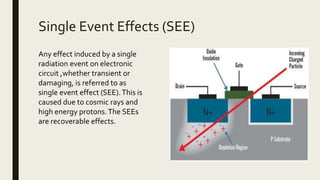FPGA in outer space
- 1. FPGA IN OUTER SPACE
- 2. FPGAs- A Basic Introduction FGPA stands for field-programmable gate array. It is a type of device that is widely used in electronic circuits. FPGAs are semiconductor devices which contain programmable logic blocks and interconnection circuits. It can be programmed or reprogrammed to the required functionality after manufacturing.
- 3. History The FPGA industry sprouted from programmable read-only memory (PROM) and programmable logic devices (PLDs). Altera was founded in 1983 and delivered the industry's first reprogrammable logic device in 1984 Xilinx co-founders Ross Freeman and BernardVonderschmitt invented the first commercially viable field-programmable gate array in 1985 – the XC2064 The 1990s were a period of rapid growth for FPGAs, both in circuit sophistication and the volume of production. In the early 1990s, FPGAs were primarily used in telecommunications and networking. By the end of the decade, FPGAs found their way into consumer, automotive, and industrial applications.
- 4. Applications of FPGA We can find them in numerous industries or applications such as the following: • Aerospace, Outer Space, and Defense • Audio, Automotive, and Broadcast • Consumer Electronics, Data Centers, and High-Performance Computing • Instruments of Science, Industrial, and Medical • Security Applications, Wired & Wireless Communications
- 5. Applications of FPGA in Outer Spcae Space environment is different from terrestrial systems in that incident radiation can cause bit flips in memory elements and ionisation failure in semiconductors.This kind of hardware faults cannot be debugged and repaired, requiring high-reliability manufacture, assembly and operating techniques.The use of run-time reconfiguration in space will allow to modify on-board hardware by replacing faulty/outdated designs at different stages of a mission. Some example applications are: rectification of design faults, improvement of processing algorithms, alteration of system functionality in response to changed mission requirements, change of hardware configurations to reduce weight and power characteristics, etc.
- 6. Why FPGA is favoured thanASIC chips? • FPGA, as the name says are field programmable. Compared to ASICs which are specifically designed to perform a standard operation by default, FPGAs can be reprogrammed. • Newer FPGAs typically has millions of gates present,which makes data processing and data compressing faster. • While using an ASIC gives a faster response, they typically need other components which FPGA,due to numerous logic structures present within, do not usually need.
- 7. Challenges faced Near-Earth and deep-space environments are full of different radiation sources. These sources include electrons, protons, and heavy ions trapped in the Van Allen Belts near the Earth. There are also galactic cosmic rays (GCRs) carrying high- energy atomic nuclei, mainly protons, alpha particles, and high-energy photons coming from solar flares. FPGAs are even more vulnerable than most kinds of electronics because SRAM FPGAs are basically just big memory devices. And, because the most common fault caused by radiation is bit-flipping in memory elements, the configuration logic itself is vulnerable to radiation – not just the data. These are broadly classified into two different effects: 1. Total ionizing dose effect 2. Single event effects
- 8. Total Ionizing Dose (TID) Effects Neutrons, protons, alpha particles, heavy ions, and very high-energy gamma rays that transfer enough energy to the silicon to displace atoms in the lattice all cause lattice defects. Charged particles and gamma rays create ionization, which can alter device parameters. These changes are called total ionizing dose (TID) effects. These can be termed as Permanent Radiation Damage To Silicon Devices.
- 9. Single Event Effects (SEE) Any effect induced by a single radiation event on electronic circuit ,whether transient or damaging, is referred to as single event effect (SEE).This is caused due to cosmic rays and high energy protons.The SEEs are recoverable effects.
- 10. Use Of FPGA in Space FPGAs can be reconfigured with a different design. It is an integrated circuit which can be “field” programmed to work as per the intended design. It means it can work as a microprocessor, or as an encryption unit, or graphics card, or even all these three at once. They are used in image and signal processing. FPGA are programmed with custom implementations of an algorithm.These algorithms are highly parallel hardware designs that are faster than software implementations. This flexibility and speed has made FPGAs attractive for many space programs that need in situ, high-speed signal processing for data categorization and data compression.
- 11. Coping with these challenges There have been two basic options for FPGAs in space applications: SRAM-type FPGAs : high-density, re-programmable, conventional, repurposed and heavily modified for space use; Antifuse FPGAs: lower-density, non-volatile, one-time-programmable, designed specifically for space applications.
- 12. Different Models of Space FPGAs XILINX- Xilinx®Virtex®-5QV Space-Grade FPGA Microsemi- • SRAM Based- RTG4 FPGAs, RT ProASIC3 FPGAs • Antifuse Based-RT ProASIC3 FPGAs, RTSX- SU FPGAs
- 13. THANKYOU












